If you’ve been watching the Olympics, you may have been confused to see winning athletes being handed not medals, but dolls of Soohorang, the official white tiger mascot of the PyeongChang Games.
You might also have wondered whether the flower bouquets, which traditionally get presented with the medals at the Olympics, have entirely disappeared.
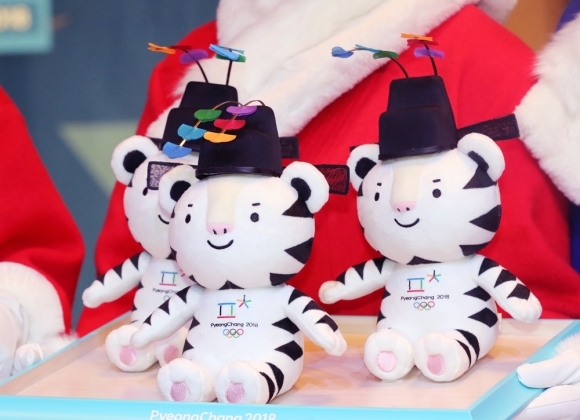
Stuffed Soohorangs wearing a usahwa hat, which are awarded to the medalists at the PyeongChang Winter Olympics (Yonhap)
Those who have been following the Summer Olympics may remember winning athletes being awarded medals shortly after completing their final event.
At the Winter Olympics, however, the medal ceremony has been a two-part event since 2006, consisting of a “venue ceremony” held immediately after the event and a “victory ceremony” in the evening.
At the event venue, the winning athletes stand on a podium and receive a Soohorang. Later, a second medal-awarding ceremony is held at the Medals Plaza at PyeongChang. Every night at 7 p.m., the winning athletes from that day and the previous evening gather at the plaza to receive their medals and hear their national anthem played.
Collective medal ceremonies like this would not be possible at a Summer Olympics, organizers say, because there are many more events -- and medals awarded -- each day.
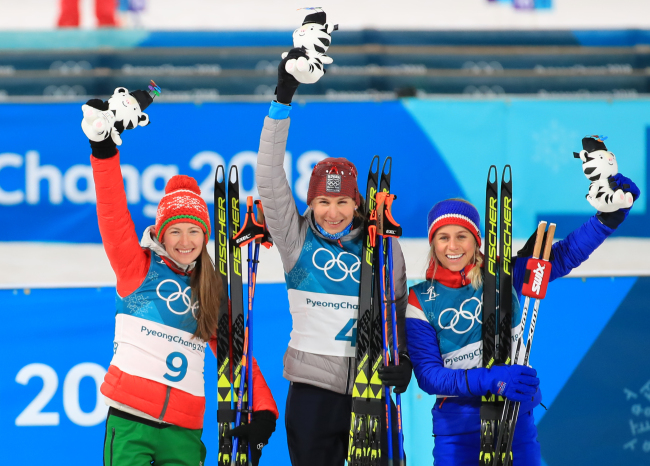
Winners of the women’s 12.5-kilometer mass start event at the Winter Olympics hold up stuffed Soohorang dolls at the Alpensia Biathlon Centre in PyeongChang, Gangwon Province, on Saturday. From left are silver medalist Darya Domracheva from Belarus, gold medalist Anastasiya Kuzmina from Slovakia and bronze medalist Tiril Eckhoff of Norway. (Yonhap)
Aside from its adorable appearance, the mini Soohorang plushie handed to the winning athlete has a special meaning tied to traditional Korean culture.
The mini Soohorang is wearing a hat adorned with colorful paper flowers, called usahwa. These flowers were bestowed by the king to those who passed the national service exam during Korea’s Joseon Dynasty (1392-1910).
In bestowing the Usahwa Soohorang to the winning Olympians, South Korea is recognizing their achievement in accordance with a Korean tradition.
The flowers decorating the hat also are part of a longstanding tradition of handing bouquets of flowers to Olympic winners. Flowers were not given out at the 2016 Rio Olympics due to Brazil’s eco-friendly Olympics pledge, and PyeongChang has continued this.
Instead of winning a medal at the Olympics, there are other ways to get your hands on an Usahwa Soohorang. The official online store for Olympic goods has sold out of nearly all of them as of now, but some may be available at the offline stores in Gangneung and PyeongChang.
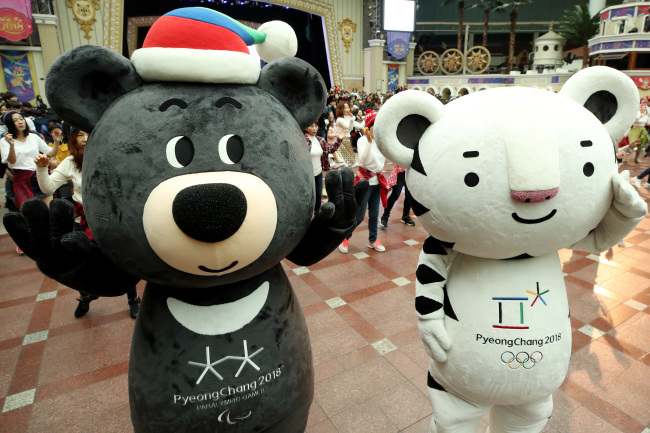
Soohorang (right) and Bandabi (left) characters are featured during a PyeongChang Olympics promotion event at the Lotte World amusement park in southeastern Seoul. (Yonhap)
Soohorang takes its motif from the white tiger, long considered to be a sacred guardian animal in Korea. Its white fur also links the animal to many of the snow and ice sports in the Winter Games.
As for its name, “Sooho,” meaning “guard” or “protection” in Korean, symbolizes the protection offered to the athletes, spectators and other participants of the 2018 Games.
“Rang” comes from the middle syllable of “Horangi,” the Korean word for “tiger,” and is also the last syllable of “Jeongseon Arirang,” a traditional folk song of Gangwon Province, where the Games will be held, according to the Olympics website.
Soohorang is not the first tiger to serve as an Olympic mascot in Korea. During the 1988 Seoul Summer Games, an orange Amur tiger named Hodori was the official mascot.
Soohorang also has a friend: Bandabi the Asiatic bear. Bandabi has been chosen as the mascot for the 2018 Paralympic Games in PyeongChang to be held from March 8-18 in PyeongChang.
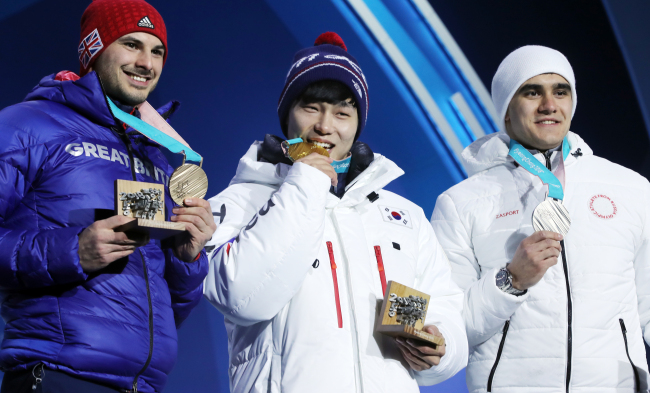
Winners of the men`s skeleton event at the Winter Olympics attend their medal ceremony at the Medals Plaza in PyeongChang, Gangwon Province, on Feb. 18. From left are silver medalist Nikita Tregubov from Russia, gold medalist Yun Sung-bin from South Korea and bronze medalist Dom Parsons from Great Britain(Yonhap)
The two-part ceremony system was adopted at the 2006 Winter Games in Torino, and has continued since then. By having a simplified ceremony on the scene, the organizers sought to protect the athletes from the harsh wind and cold at many of the outdoor events.
By having the formal medal ceremony in the evening, the athletes are also congratulated by more people, including those unable to make it to the actual final of the event.
However, the medal ceremony is held right after the end of the finals for seven sports disciplines at PyeongChang. They include men’s and women’s hockey, curling, speedskating mass start and four-man bobsleigh.
A total of 93 medal ceremonies are being held at the Medals Plaza. The medalists from the last two events in cross-country, the men’s 50km mass start classic and the ladies' 30km mass start classic, will be awarded during the closing ceremony on Sunday.
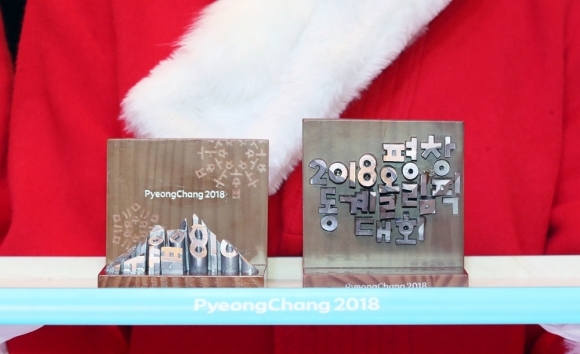
Square plaques are bestowed to Olympic medalists at the PyeongChang Winter Games. They combine wood and metal to form an image of the mountains of PyeongChang in 3-D. They also create snowflakes using letters from Hangeul, the Korean alphabet. (Yonhap)
While watching the evening medal event, you may have also noticed the winning athletes are handed a square wooden plaque alongside their Olympic gold, silver and bronze medals.
According to the PyeongChang Olympics Committee, the square plaques combine wood with metal to form the image of the mountains of PyeongChang in 3-D. It also depicts snowflakes using letters from Hangul, the Korean alphabet.
The wooden plaques were created as a replacement for the flower bouquets traditionally handed to winning athletes, in line with the idea that it was wasteful to prepare thousands of expensive bouquets that would just be tossed away later.
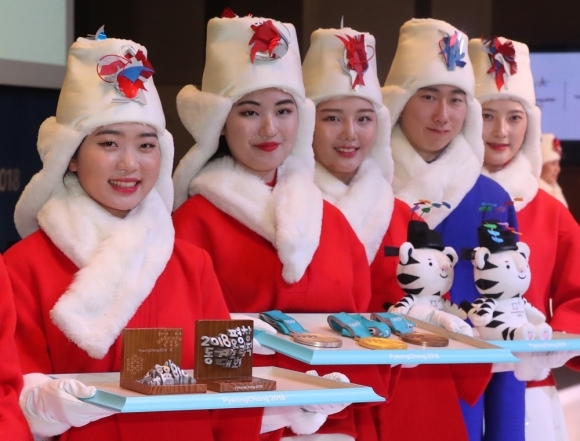
Medal deliverers at the PyeongChang Winter Olympics (Yonhap)
The PyeongChang Olympics Committee has put a great deal of effort into designing the outfit for the medal deliverers who bring the medals and plaques to the winning Olympians at the ceremony.
The medal deliverers wear winter hanboks, Korean traditional attire characterized by vibrant colors and simple lines without pockets. Their specialized hanboks put together the colors red, blue and white which are found in the Korean national flag, the Taegukki.
The winter look features other traditional items such as a durumagi, a jacket worn over the regular pieces of hanbok, as well as a pungcha, a traditional winter hat, and hanbok scarves. The garments are all sufficiently padded to keep the staff warm in the cold.
The attire comes in four types, one for the snow sports ceremony, ice sports ceremony and a men’s and women’s outfit for the Medal Plaza ceremony, according to organizers.
By Sohn Ji-young (
jys@heraldcorp.com)











